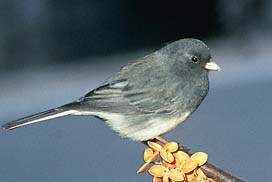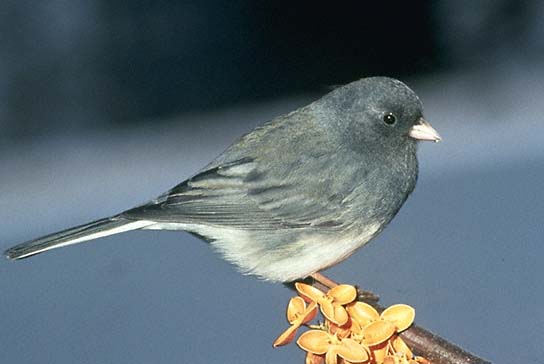Perching Birds
Description
5-6 1/4" (13-16 cm). This species shows much geographic variation in color. Typically, male of western population ("Oregon Junco") has black hood, chestnut mantle, white underparts with buff sides. Eastern male ("Slate-colored Junco") is dark slate-gray on head, upper breast, flanks, and upperparts, with white lower breast and belly. Both forms have pink bill and dark gray tail with white outer tail feathers conspicuous in flight. The pine forests of the Black Hills in western South Dakota and eastern Montana have an isolated population ("White-winged Junco") similar to the eastern form but with 2 white wing bars and extensive white outer tail feathers. Birds of the Southwest ("Gray-headed Juncos") are gray overall, with a reddish-brown back. Female "Oregon Junco" has gray hood; females of all forms less colorful.
Voice
Ringing metallic trill on the same pitch. Members of a flock may spread out widely, keeping in contact by constantly calling tsick or tchet. Also a soft buzzy trill in flight.
Habitat
Openings and edges of coniferous and mixed woods; in winter, fields, roadsides, parks, suburban gardens.
Nesting
3-6 pale bluish or greenish eggs, with variegated blotches concentrated at the larger end, in a deep, compact nest of rootlets, shreds of bark, twigs, and mosses, lined with grasses and hair, placed on or near the ground, protected by a rock ledge, a mud bank, tufts of weeds, or a fallen log.
Range
Breeds from Alaska east across Canada to Newfoundland, south to mountains in Mexico and Georgia. Winters south to Gulf Coast and northern Mexico.
Discussion
This lively territorial bird is a ground dweller and feeds on seeds and small fruits in the open. It also moves through the lower branches of trees and seeks shelter in the tangle of shrubs. Until recently the many geographical forms of this bird were considered separate species, but since they interbreed wherever their ranges meet, they are now considered one species.


